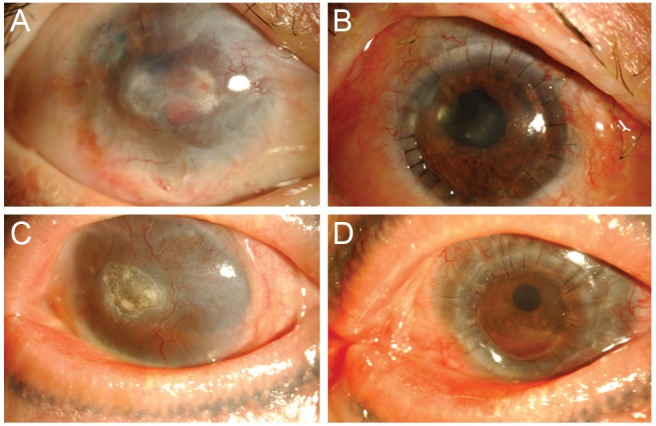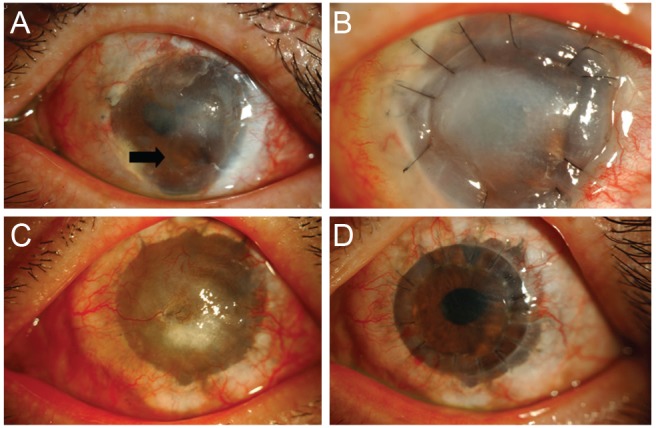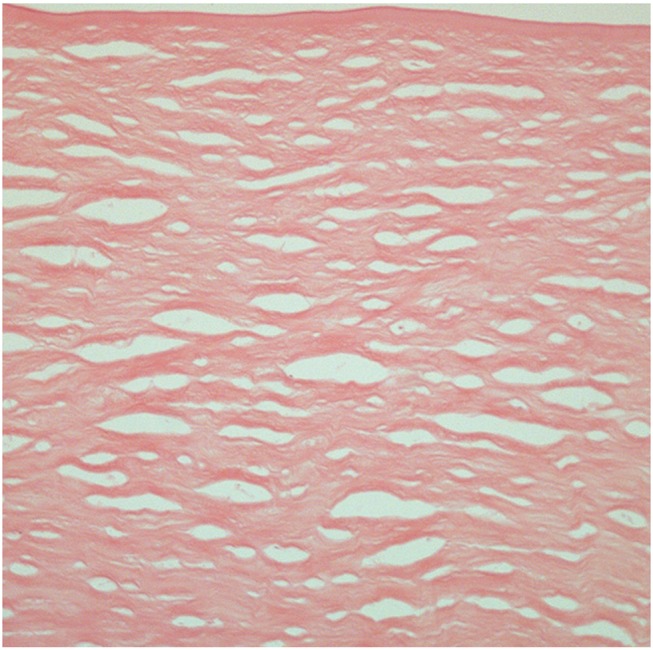Korean J Ophthalmol.
2015 Apr;29(2):79-85. 10.3341/kjo.2015.29.2.79.
Deep Anterior Lamellar Keratoplasty Using Irradiated Acellular Cornea with Amniotic Membrane Transplantation for Intractable Ocular Surface Diseases
- Affiliations
-
- 1Department of Ophthalmology, Chung-Ang University Hospital, Chung-Ang University College of Medicine, Seoul, Korea. jck50ey@kornet.net
- KMID: 2363712
- DOI: http://doi.org/10.3341/kjo.2015.29.2.79
Abstract
- PURPOSE
To report the clinical outcomes of deep anterior lamellar keratoplasty (DALK) when sterile gamma-irradiated acellular corneal tissues (VisionGraft) are used in combination with amniotic membrane transplantation (AMT) for intractable ocular surface diseases.
METHODS
The medical records of fifteen patients who had DALK with AMT were retrospectively reviewed. Indications for surgery included ocular burn, bacterial keratitis, herpes simplex virus keratitis, corneal opacity with Stevens-Johnson syndrome, Mooren's ulcer, idiopathic myxoid degeneration of corneal stroma, and recurrent band keratopathy. DALK was performed using partial-thickness acellular corneal tissue and a temporary amniotic membrane patch was added at the end of the operation.
RESULTS
All cases that underwent DALK with AMT became epithelialized within 2 postoperative weeks. Twelve patients showed favorable outcomes without graft rejection, corneal opacification, or neovascularization. The other three grafts developed corneal opacification and neovascularization, and required additional penetrating keratoplasty (PK). Unlike the results of previous PKs, there were no graft rejections and the graft clarity was well-maintained in these three cases for at least 8 months after PK.
CONCLUSIONS
DALK using sterile acellular corneal tissues in combination with AMT may be a good therapeutic strategy for treating intractable ocular surface diseases because of lowered immune rejection, fibroblast activation, and facilitation of epithelialization. Furthermore, DALK can help stabilize the ocular surface, prolong graft survival, and may allow better outcomes when combined with subsequent PK.
Keyword
MeSH Terms
Figure
Reference
-
1. Sedlakova K, Filipec M. Effect of suturing technique on corneal xenograft survival. Cornea. 2007; 26:1111–1114. PMID: 17893545.
Article2. Li N, Wang X, Wan P, et al. Tectonic lamellar keratoplasty with acellular corneal stroma in high-risk corneal transplantation. Mol Vis. 2011; 17:1909–1917. PMID: 21850165.3. Shimmura S, Shimazaki J, Tsubota K. Therapeutic deep lamellar keratoplasty for cornea perforation. Am J Ophthalmol. 2003; 135:896–897. PMID: 12788136.
Article4. Xie L, Shi W, Liu Z, Li S. Lamellar keratoplasty for the treatment of fungal keratitis. Cornea. 2002; 21:33–37. PMID: 11805504.
Article5. Kamiya K, Hori J, Kagaya F, et al. Preservation of donor cornea prevents corneal allograft rejection by inhibiting induction of alloimmunity. Exp Eye Res. 2000; 70:737–743. PMID: 10843778.
Article6. King JH Jr, Townsend WM. The prolonged storage of donor corneas by glycerine dehydration. Trans Am Ophthalmol Soc. 1984; 82:106–110. PMID: 6398932.7. Anderson DF, Ellies P, Pires RT, Tseng SC. Amniotic membrane transplantation for partial limbal stem cell deficiency. Br J Ophthalmol. 2001; 85:567–575. PMID: 11316719.
Article8. Azuara-Blanco A, Pillai CT, Dua HS. Amniotic membrane transplantation for ocular surface reconstruction. Br J Ophthalmol. 1999; 83:399–402. PMID: 10434859.
Article9. Fontana L, Parente G, Tassinari G. Clinical outcomes after deep anterior lamellar keratoplasty using the big-bubble technique in patients with keratoconus. Am J Ophthalmol. 2007; 143:117–124. PMID: 17188045.
Article10. Utine CA, Tzu JH, Akpek EK. Lamellar keratoplasty using gamma-irradiated corneal lenticules. Am J Ophthalmol. 2011; 151:170–174.e1. PMID: 21145036.
Article11. Daoud YJ, Smith R, Smith T, et al. The intraoperative impression and postoperative outcomes of gamma-irradiated corneas in corneal and glaucoma patch surgery. Cornea. 2011; 30:1387–1391. PMID: 21993467.
Article12. Akpek EK, Aldave AJ, Aquavella JV. The use of precut, γ-irradiated corneal lenticules in Boston type 1 keratoprosthesis implantation. Am J Ophthalmol. 2012; 154:495–498.e1. PMID: 22633353.
Article13. Yokomise H, Inui K, Wada H, et al. High-dose irradiation prevents rejection of canine tracheal allografts. J Thorac Cardiovasc Surg. 1994; 107:1391–1397. PMID: 8196378.
Article14. Moller-Pedersen T. On the structural origin of refractive instability and corneal haze after excimer laser keratectomy for myopia. Acta Ophthalmol Scand Suppl. 2003; (237):1–20. PMID: 12708993.15. Moller-Pedersen T. Keratocyte reflectivity and corneal haze. Exp Eye Res. 2004; 78:553–560. PMID: 15106935.16. Meller D, Tseng SC. Conjunctival epithelial cell differentiation on amniotic membrane. Invest Ophthalmol Vis Sci. 1999; 40:878–886. PMID: 10102284.17. Kruse FE, Rohrschneider K, Volcker HE. Multilayer amniotic membrane transplantation for reconstruction of deep corneal ulcers. Ophthalmology. 1999; 106:1504–1510. PMID: 10442895.
Article18. Tseng SC, Prabhasawat P, Barton K, et al. Amniotic membrane transplantation with or without limbal allografts for corneal surface reconstruction in patients with limbal stem cell deficiency. Arch Ophthalmol. 1998; 116:431–441. PMID: 9565039.
Article19. Tseng SC, Li DQ, Ma X. Suppression of transforming growth factor-beta isoforms, TGF-beta receptor type II, and myofibroblast differentiation in cultured human corneal and limbal fibroblasts by amniotic membrane matrix. J Cell Physiol. 1999; 179:325–335. PMID: 10228951.20. Koizumi NJ, Inatomi TJ, Sotozono CJ, et al. Growth factor mRNA and protein in preserved human amniotic membrane. Curr Eye Res. 2000; 20:173–177. PMID: 10694891.
Article21. Fogla R, Padmanabhan P. Deep anterior lamellar keratoplasty combined with autologous limbal stem cell transplantation in unilateral severe chemical injury. Cornea. 2005; 24:421–425. PMID: 15829798.
Article22. Terry MA. The evolution of lamellar grafting techniques over twenty-five years. Cornea. 2000; 19:611–616. PMID: 11009313.
Article23. Tsubota K, Kaido M, Monden Y, et al. A new surgical technique for deep lamellar keratoplasty with single running suture adjustment. Am J Ophthalmol. 1998; 126:1–8. PMID: 9683143.
Article24. Seitz B, Cursiefen C, El-Husseiny M, et al. DALK and penetrating laser keratoplasty for advanced keratoconus. Ophthalmologe. 2013; 110:839–848. PMID: 23990151.
- Full Text Links
- Actions
-
Cited
- CITED
-
- Close
- Share
- Similar articles
-
- Human Amniotic Membrane Transplantation for Treatment of Fungal Ulcer
- Clinical Evaluation of Full-thickness Deep Lamellar Keratoplasty
- New Treatment for Band Keratopathy: Superficial Lamellar Keratectomy, EDTA Chelation and Amniotic Membrane Transplantation
- Lamellar Corneal Graft Using Acellular Preserved Human Cornea for Perforated Anterior Scleral Staphyloma
- A Case of Double Descemet's Membrane after Penetrating Keratoplasty Converted from Deep Anterior Lamellar Keratoplasty




